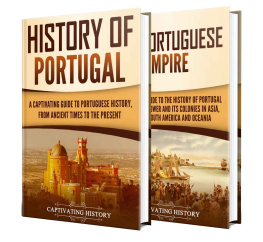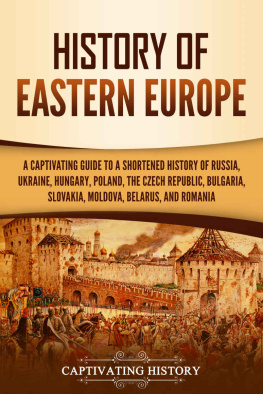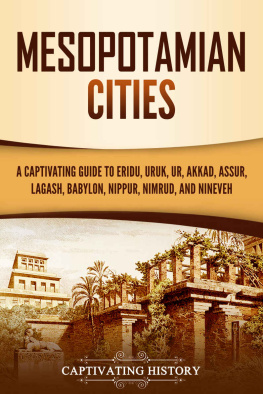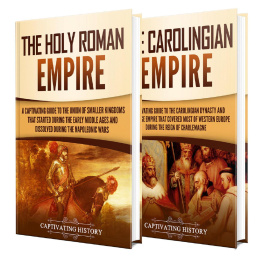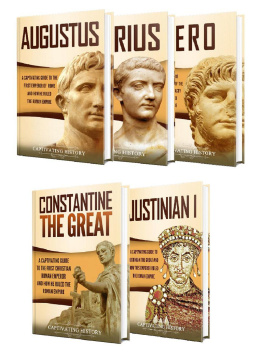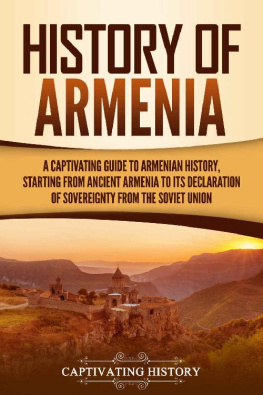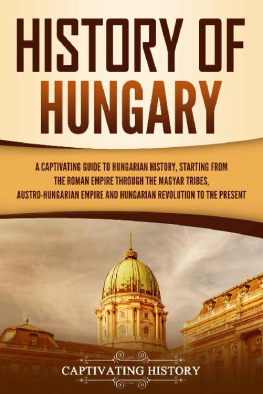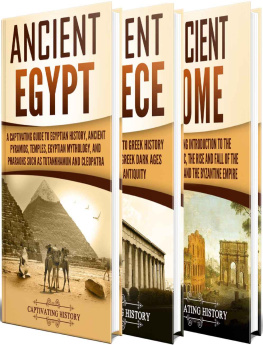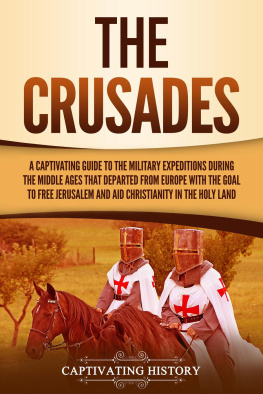Captivating History - The Holy Roman Empire: A Captivating Guide to the Union of Smaller Kingdoms That Started During the Early Middle Ages and Dissolved During the Napoleonic Wars
Here you can read online Captivating History - The Holy Roman Empire: A Captivating Guide to the Union of Smaller Kingdoms That Started During the Early Middle Ages and Dissolved During the Napoleonic Wars full text of the book (entire story) in english for free. Download pdf and epub, get meaning, cover and reviews about this ebook. year: 2019, genre: Detective and thriller. Description of the work, (preface) as well as reviews are available. Best literature library LitArk.com created for fans of good reading and offers a wide selection of genres:
Romance novel
Science fiction
Adventure
Detective
Science
History
Home and family
Prose
Art
Politics
Computer
Non-fiction
Religion
Business
Children
Humor
Choose a favorite category and find really read worthwhile books. Enjoy immersion in the world of imagination, feel the emotions of the characters or learn something new for yourself, make an fascinating discovery.

- Book:The Holy Roman Empire: A Captivating Guide to the Union of Smaller Kingdoms That Started During the Early Middle Ages and Dissolved During the Napoleonic Wars
- Author:
- Genre:
- Year:2019
- Rating:3 / 5
- Favourites:Add to favourites
- Your mark:
- 60
- 1
- 2
- 3
- 4
- 5
The Holy Roman Empire: A Captivating Guide to the Union of Smaller Kingdoms That Started During the Early Middle Ages and Dissolved During the Napoleonic Wars: summary, description and annotation
We offer to read an annotation, description, summary or preface (depends on what the author of the book "The Holy Roman Empire: A Captivating Guide to the Union of Smaller Kingdoms That Started During the Early Middle Ages and Dissolved During the Napoleonic Wars" wrote himself). If you haven't found the necessary information about the book — write in the comments, we will try to find it.
Captivating History: author's other books
Who wrote The Holy Roman Empire: A Captivating Guide to the Union of Smaller Kingdoms That Started During the Early Middle Ages and Dissolved During the Napoleonic Wars? Find out the surname, the name of the author of the book and a list of all author's works by series.
The Holy Roman Empire: A Captivating Guide to the Union of Smaller Kingdoms That Started During the Early Middle Ages and Dissolved During the Napoleonic Wars — read online for free the complete book (whole text) full work
Below is the text of the book, divided by pages. System saving the place of the last page read, allows you to conveniently read the book "The Holy Roman Empire: A Captivating Guide to the Union of Smaller Kingdoms That Started During the Early Middle Ages and Dissolved During the Napoleonic Wars" online for free, without having to search again every time where you left off. Put a bookmark, and you can go to the page where you finished reading at any time.
Font size:
Interval:
Bookmark:
The Holy Roman Empire
A Captivating Guide to the Union of Smaller Kingdoms That Started During the Early Middle Ages and Dissolved During the Napoleonic Wars
Copyright 2019
All Rights Reserved. No part of this book may be reproduced in any form without permission in writing from the author. Reviewers may quote brief passages in reviews.
Disclaimer: No part of this publication may be reproduced or transmitted in any form or by any means, mechanical or electronic, including photocopying or recording, or by any information storage and retrieval system, or transmitted by email without permission in writing from the publisher.
While all attempts have been made to verify the information provided in this publication, neither the author nor the publisher assumes any responsibility for errors, omissions or contrary interpretations of the subject matter herein.
This book is for entertainment purposes only. The views expressed are those of the author alone and should not be taken as expert instruction or commands. The reader is responsible for his or her own actions.
Adherence to all applicable laws and regulations, including international, federal, state and local laws governing professional licensing, business practices, advertising and all other aspects of doing business in the US, Canada, UK or any other jurisdiction is the sole responsibility of the purchaser or reader.
Neither the author nor the publisher assumes any responsibility or liability whatsoever on the behalf of the purchaser or reader of these materials. Any perceived slight of any individual or organization is purely unintentional.
Table of Contents
Hi History Lovers!
My name is Matt Clayton, and Im the creator of Captivating History. First off, I want to THANK YOU for reading our books in the Captivating History series. As an avid reader of History myself, I aim to produce books that will hold you captive.
Now you have a chance to join our exclusive history list so you can get the ebook below for free as well as discounts and a potential to get more history books for free! Simply click the link below to join.
P.S. If you join now, you will also receive a free Mythology book. Remember that its 100% free to join the list.

Click here to access your bonus
Also, make sure to follow us on:
Twitter: @Captivhistory
Facebook: Captivating History: @captivatinghistory
A red-bearded king with a blazing sword swept away by the river in his last crusade. A sacrilegious young pope engaged in much debauchery. A fierce foreign princess with an ax to grind and a knack for diplomacy. A dowager empress who refused to let her family down, no matter the cost. An ambitious teenage princess marrying for power and grappling for the right to her throne. A romantic poet, his heart long lost on a woman with whom hed exchanged but one word. And, at the end of it all, a rising tyrant with a blow that felled empires.
These read like the characters of some exciting fantasy, a concoction of imagination to enchant and delight readers. Yet every single one of them was as real as you and me. And they all populated, at some time or another, an empire whose might would hold for a thousand years and whose borders would expand to swallow up the majority of Western Europe: The Holy Roman Empire.
Beginning with Charlemagne, the great and educated king who would serve as an inspiration for world leaders from Frederick II to Adolf Hitler, the Holy Roman Empires intricate ties with the Roman Catholic Church would provide for plenty of excitement and drama in its early years. However, as the empire staggered through the Middle Ages and into the Renaissance, it would eventually be forced to declare its allegiance with a new way of thinking: Protestantism.
Throughout the story of the Holy Roman Empire, a wealth of fascinating tales from interesting people proliferates. Monks and emperors will clash, poets sing the praises of kings, and the pope rides blind and bareback on a frightened donkey through the streets of Rome. The mightiest monarch in all of Europe walks barefoot in the snow in repentance for his angry deeds, and two rival families stand toe-to-toe for the monarchy. Crusades are lost in war and won in diplomacy, while kings are held ransom, revolts are suppressed, and antipopes crowned. And this incredible tale spanning a full millennium is ready and waiting for you to turn the next page.
Historians still remain in dispute over the ethnicity of Flavius Odoacer.
A tall, lean, powerfully built man, Odoacer was a soldier from the top of his head to the worn-out soles of his boots. The naked sword in his hand was not quite as sharp as the flash of fire in his eyes as he towered over the emperor of ancient Rome, demanding his surrender. Whether he was a member of the Germanic tribes acting independently, a former soldier of the Roman army, or even a Hun, it mattered little to the young emperor, Romulus Augustus, who now faced Odoacers bare blade. Romulus had been raised in a cushioned and privileged life in Ravenna as the son of an important commander in the Roman army, and he knew only one thing for sure about the strange mustachioed man who was bent on killing him unless he gave up the empire: Odoacer was a barbarian. And to the noble-blooded young Roman, barbarian meant anyone who came from outside the borders of his empire.
Once, the Roman Empire had been the greatest power in Europe, its borders stretching all the way from Egypt to Great Britain to Gaul to Asia Minor. But now, it was reduced to this single moment: a teenage emperor cowering before a barbarian, trying to decide whether or not to surrender.
* * * *
It was somewhat ironic that Romulus Augustus, who is often seen as the last emperor of Rome, bore those names.
His first name, Romulus, was then widely believed to be the root of the name Rome. The foundation myth of ancient Rome revolves around two brothers named Romulus and Remus, the sons of a Vestal Virgin and either Mars (the Roman god of war) or Hercules (a demigod hero in Roman mythology). Like Moses in the Nile, Romulus and Remus were thrown into the Tiber River of Italy as babies by a vengeful ruler, being swept away on its turbulent waters. Washed up on the shore, a wild she-wolf discovered the two little babies and suckled them, keeping them alive until a shepherd stumbled upon them and adopted them as his own. As adults, Romulus and Remus were determined to found a city on the very hills that they had roamed with their wild parent when they were just babies. When they couldnt agree on which hill to build the city on, Romulus killed Remus and built his city on Palatine Hill, giving the city his nameRome.
This story is now known to be pure mythology. In fact, the city of Rome was likely the result of a group of villages banding together against a common foe sometime in the 7 th century BCE. The fledgling town proved to be more powerful than expected; military conquest after military conquest developed it into the city of Rome, and soon, it was ruled over by six kings whogenerallyworked together to grow their communal power. However, this history had been largely forgotten by the Romans themselves in the hundreds of years between the founding of Rome around 625 BCE and the birth of its last emperor in 460 CE, and they firmly believed in the myth of Romulus and Remus. Romulus Augustus father, Orestes, was a general of the Roman army in a time when the once-great Roman Empire was falling apart. Perhaps envisioning a rebirth of its former glory, he named his child after its mythical founder.
Font size:
Interval:
Bookmark:
Similar books «The Holy Roman Empire: A Captivating Guide to the Union of Smaller Kingdoms That Started During the Early Middle Ages and Dissolved During the Napoleonic Wars»
Look at similar books to The Holy Roman Empire: A Captivating Guide to the Union of Smaller Kingdoms That Started During the Early Middle Ages and Dissolved During the Napoleonic Wars. We have selected literature similar in name and meaning in the hope of providing readers with more options to find new, interesting, not yet read works.
Discussion, reviews of the book The Holy Roman Empire: A Captivating Guide to the Union of Smaller Kingdoms That Started During the Early Middle Ages and Dissolved During the Napoleonic Wars and just readers' own opinions. Leave your comments, write what you think about the work, its meaning or the main characters. Specify what exactly you liked and what you didn't like, and why you think so.

